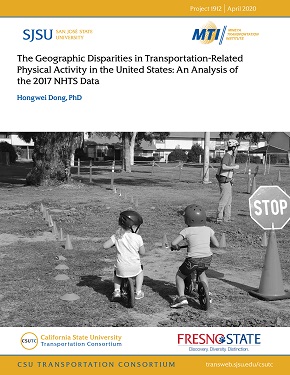- 408-924-7560
- mineta-institute@sjsu.edu
- Donate
The Geographic Disparities in Transportation-Related Physical Activity in the United States: An Analysis of the 2017 NHTS Data
Research on the relationship between urbanicity and physical activity yielded mixed results despite many studies consistently showing that residents tended to undertake more transportation-related physical activity in a more urban environment. This study analyzed the 2017 NHTS data to examine the geographic disparities in physical activity, particularly transportation-related physical activity in the United States. Our analysis suggests the relationship between urbanicity and physical activity demonstrates a flat U-shape in graphed data. Residents are more physically active when they live in the areas from the two ends of the urbanization spectrum: inner cities and inner suburbs of large metropolitan areas and the rural parts of non-metropolitan areas. Suburbanites, particularly mid-ring and outer-ring suburbanites walk the least. Only very slight geographic variation exists in the weekly rates of walk and bike trips that are strictly for exercise. The study revealed greater variation of the weekly rates of walk and bike trips that are for non-exercise purposes. This study suggests a more complicated relationship between urbanicity, active travel, and physical activity in a broader geographic context. More research needs to examine whether and how new urbanist design can promote active travel, particularly active travel strictly for exercise, in rural areas and areas of low urbanicity.
HONGWEI DONG
Dr. Hongwei Dong is an Associate Professor in the Department of Geography and City & Regional Planning at the California State University Fresno. His research interests include housing, transportation, and healthy cities. His research articles are published in top planning journals such as Journal of the American Planning Association, Journal of Planning Education and Research, Urban Studies, and Journal of Transport Geography. The National Science Foundation (NSF) funded his research on neighborhood environment, physical activity, and mental wellbeing in disadvantaged communities in Fresno. Gideon Marsh is a graduate student in the Department of Computer Science at the California State University, Fresno. He received his Bachelor degrees in Computer Science and Mathematics-Computer Science from the Southern Oregon University.
-
Contact Us
San José State University One Washington Square, San Jose, CA 95192 Phone: 408-924-7560 Email: mineta-institute@sjsu.edu






